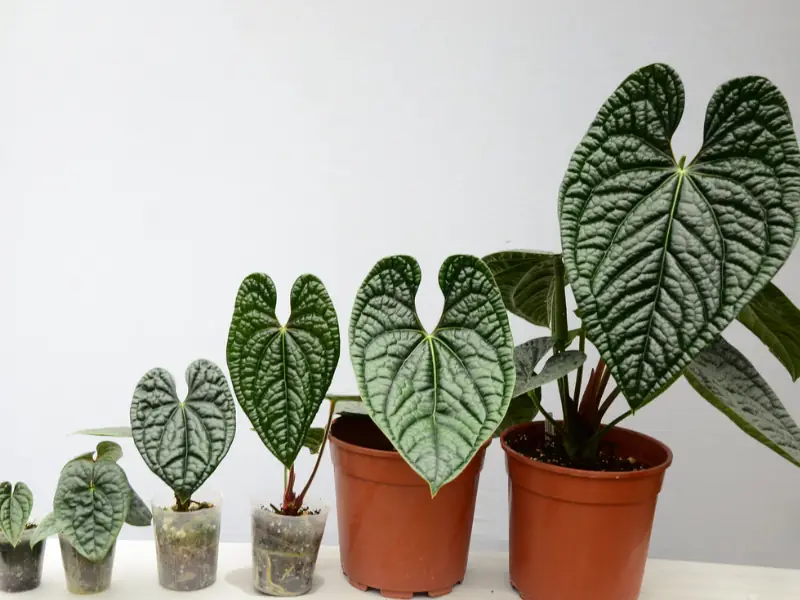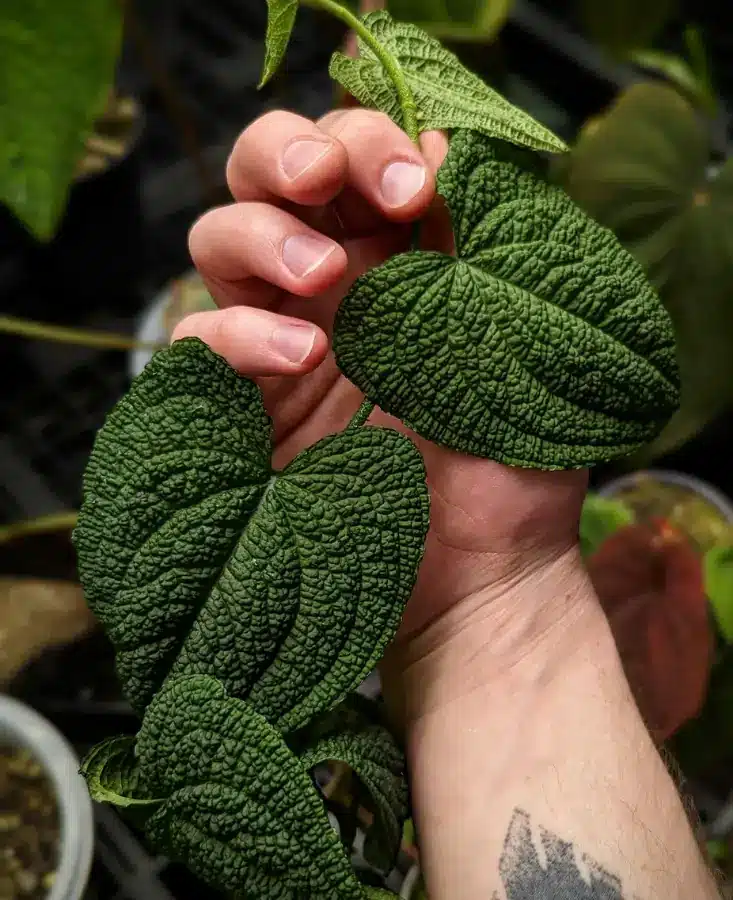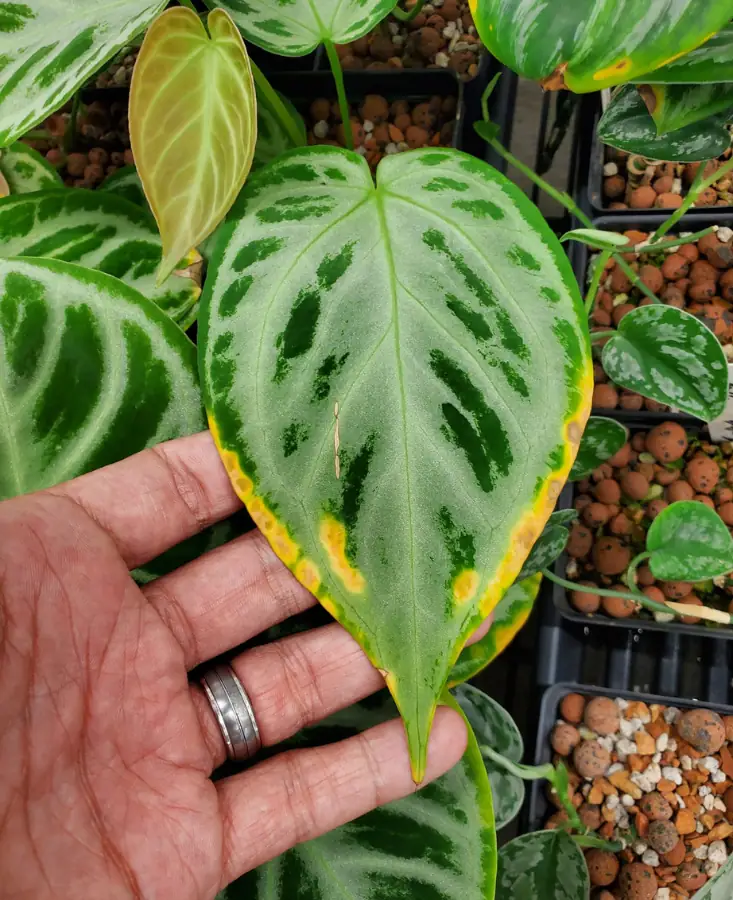Anthurium Care 101: Propagation, Water, Light, Soil & More
The anthurium plant (Anthurium sp) is a genus of flowering plants comprising about 1000 species. It is native to the tropical regions of Central and South America, specifically Columbia and Ecuador. The plant is popularly grown as an ornamental houseplant for its colorful, long-lasting blooms and attractive foliage.

I have a fast-growing red anthurium that’s always rewarding me with long-lasting blooms yearly. I divide it whenever I feel it has outgrown its pot, gift away the babies, and keep the original plant.
In this article, I will share a detailed care guide for growing anthuriums indoors. If you like such houseplants, you can also check out my other guides on great plants for your porch and growing lavender trees in pots.
Anthurium overview
The name Anthurium is Greek for tail flower, as all species have that unique tail like spadix. Here’s an overview of the plant.
| Names | Anthurium; laceleaf; flamingo flower; tailflower |
| Scientific name | Anthurium spp. |
| Origin | The Americas (Columbia, Ecuador), Caribbean |
| Sunlight | Bright indirect light |
| Soil pH | Acidic: 5.5 – 6.5 |
| Temperature | 61–72 °F |
| Watering | Weekly |
| Bloom colors | Pink, red, orange, green, purple, black, yellow, salmon, blue, or multicolored. |
| Lifespan | At least 5 years. |
| Size | 18 inches as houseplants |
| Type | Herb; perennial epiphyte |
Classification
- Class: Angiospermae
- Order: Alismatales
- Family: Araceae
- Genus: Anthurium
- Species: Anthurium spp.

The class of Anthurium is Magnoliopsida (or Angiospermae), which refers to flowering plants. The order is Alismatales, which includes aquatic and marsh plants and many ornamental plants. The family is Araceae, also known as the arum family, and includes other popular ornamental plants like Philodendron and Calla Lily.
The genus Anthurium comprises more than 1000 species, including the common Anthurium andraeanum and Anthurium scherzerianum.
Identification and characteristics
- Heart-shaped leaves: Most varieties of Anthurium have large, glossy, heart-shaped leaves with a deep shade of green, although some varieties are variegated.
- Colorful spathes: Anthuriums produce brightly colored spathes that can be red, pink, orange, white, or a blend of these colors.
- Many anthuriums are epiphytic, meaning they grow and depend on other plants for nutrients and water.
- They have a spadix – a fleshy axis surrounded by small, densely-packed flowers.
Author’s note: Depending on the variety of anthurium, the spathes may be wrinkled, smooth, or waxy, but the standout feature is that they’re heart-shaped.
How to Grow and Care for Anthuriums
Anthuriums need proper attention to thrive and do great indoors and in greenhouse environments. While they can bloom all year round, they only do so when provided with proper care and growing conditions.
Here’s how to grow anthuriums indoors:
Starting the plant
You can start anthurium from seeds or propagate it by division or from cuttings. All the methods work, but propagating cuttings is quicker at getting to the flower.
Planting seeds
Seeds are collected from mature flowers. The best medium for starting the seeds is a sterile seed starting mix or moistened vermiculite. Sow the seeds in the starting medium, spacing them 1 to 1.5 inches apart. Cover the container with a plastic bag to keep the seeds warm and speed up germination.
Seedlings will emerge after one to two weeks but do not transplant them into their individual pots until when they’re large enough to handle.
Pro tip: Once in a while, open the plastic bag for aeration, which will help prevent mold from growing on the starting mix.
Propagation through division and cuttings are faster, more-preferred ways to start new Anthurium plants compared to growing them from seeds. In addition, cuttings are a sure way of getting flowers identical to the parent plant, unlike when you grow new plants from seeds.
I’ve outlined these two methods of growing anthurium below under propagation.
Here are the care requirements of anthurium:
Water
Anthuriums prefer moist soil to grow healthy and bloom. If you live in hot regions, your flamingo plant will require more frequent watering compared to cold climates.
Anthurium plants like to be kept in moist soil, so the rule of thumb is to water thoroughly and evenly across the top of the plant’s soil when the top inch of soil is dry. Continue watering until the water has made its way out of the drainage hole.
Remember, these plants want a rainforest-like environment, so watering until the excess of it drains out is how you can be sure that the roots even at the bottom of the planter have had access to the water.
Dispose of the water collected in your tray after 20 minutes or so.
Remember, anthuriums don’t like sitting in water, so avoid overwatering them. Soggy soil causes root rot disease that can kill the plant.
How do you know when an anthurium needs water?
The best way to know your flamingo plant needs water is to check the soil regularly. stick your finger into the soil to check for moisture. If the finger comes up dry, it’s time to water.
Other signs your plant needs watering include:
- Wilting or drooping leaves.
- Brown leaf tips in cases of severe underwatering.
- Drooping and falling flowers due to loss of turgor pressure.
Expert tip: The signs of overwatering and underwatering in anthuriums can overlap. The most reliable way to determine if your plant needs water is to check the soil for moisture content.
A good practice is to water anthurium once every week with about half a cup of water to keep the soil moist. They love humidity, but their roots like to be slightly dry in between watering.
Misting
The native range of flamingo lilies consists of rainforests, which are always humid. Therefore, consider regular misting with room temperature water or setting up a plant humidifier, especially in dry environments or during winter when indoor heating dries out the air.
Mist the leaves lightly and avoid getting water on the flowers.
Note that misting is not a substitute for watering.
Sunlight
Anthurium plants prefer bright, indirect light but can tolerate a few hours of direct sunlight. Place potted anthuriums near an east-facing window for them to enjoy the gentle morning sunlight. If you don’t have an east-facing window, place the plant a few feet from a south or west-facing window.
The plant needs at least 6 hours of bright, indirect light daily to grow and bloom properly. If you place your flamingo lily in too much sunlight, the leaves will get scorched, and the plant will look unhealthy.
Use shears to block excess light from your windows if it is too much for your houseplants.
You can tell your anthurium isn’t getting enough sunlight if it becomes leggy, leaves turn yellow, and the plant fails to bloom for a long period.
Humidity
The ideal humidity for anthuriums is at least 50%. The plant prefers high humidity, so a range of 50-80% humidity will promote healthy foliage and flowers.
In tropical rainforests, the high temperatures maintain humidity levels at 77% and 88%, so you want to strive to give your houseplant enough moisture in the air, especially during the dry months of winter.
Here are practical ways to improve humidity around houseplants:
- Pebble tray. I use clay hydroponic balls for all of my pebble trays. These clay balls absorb water and release it slower than actual pebbles. I have pebble trays made out of decorative dishes sitting all around the floor of my home. I then have pebble trays under individual plants that like higher localized humidity, like anthuriums.
- Humidifier. A humidifier is a good choice, especially for smaller rooms where the humidity can be more condensed. Do not use hard water in a humidifier.
- Misting. Misting is temporary but will raise humidity briefly while the water evaporates. To raise humidity substantially, you would have to do a lot of misting frequently.
- Grouping plants together. As plants transpire, they release water from stomatal openings. Large groups of plants can help them maintain a localized higher humidity. However, if the home’s humidity is really low, the groupings will not help.
I recommend using a digital humidity meter to monitor your indoor humidity levels.
Soil pH
Anthuriums are epiphytes that have evolved to thrive in acidic soil conditions. They prefer a soil pH range of 5.5 to 6.5. Use a soil mix made for anthuriums to ensure they grow in the right soil conditions.
In alkaline soil, the plant will experience stunted growth and some signs of nutrient deficiency. The absorption of phosphates, born, and copper is hindered in alkaline soil, while the absorption of nitrogen, sulfur, and molybdenum decreases in highly acidic soil.
Pro tip: Use a soil pH test kit to troubleshoot acidity issues affecting nutrient availability. Signs of nutrient deficiency such as stunted growth, chlorosis, failure to bloom, and small, less colorful flowers also double up as signs of incorrect soil pH in most houseplants.
Temperature
Most tropical plants are sensitive to temperature changes because it affects their humidity and water needs.
The ideal temperature for anthuriums is 75º to 85ºF during the daytime and 70° to 75°F at night. While the plant can tolerate slightly lower or higher temperatures than this range, it’ll show signs of stress, such as yellowing leaves, wilting, or stunted growth.
Soil for anthurium
Anthuriums prefer a well-draining, acidic soil mix. The ideal growing medium should be coarse and loose for improved drainage. A combination of an orchid potting mix mixed with pine bark, peat, and perlite makes good soil for anthuriums.
Here’s a soil mix recipe for anthuriums:
- 1/2 potting soil
- 1/2 cactus soil
- 20% perlite
- 20% orchid bark
You can mix in some bone meal fertilizer to feed the anthuriums and encourage them to bloom longer.
Peat moss on its own is VERY dense and holds too much moisture. I recommend adding a bit of perlite and some bark to help with drainage.
Avoid using garden soil and compost in potting mix when starting anthuriums because these may contain microbes that can cause root rot and other plant diseases that can kill your anthuriums.
Fertilizer
Anthuriums are not heavy feeders but need to be fertilized sparingly. A phosphorus-rich fertilizer is best for healthy plants and blooms. The rule of thumb is to fertilize anthurium every two weeks during the spring and summer months when the plant is actively growing.
Avoid applying too much fertilizer, as this encourages too much foliage without blooms.
Do not feed your flamingo plant during the fall and winter months because there’s little growth, and the plant will likely be dormant.
Propagating Anthurium
Mature anthurium plants develop lateral roots along their stems to help them absorb moisture and grab objects. Snipping and propagating some in new media is an excellent way to clean up the mother plant and have new anthurium plants.
The best time to cut and propagate anthurium is during active growth in spring and early summer. Avoid propagating dormant plants as they may not recover from the shock.
Here’s how to propagate the flamingo plant:
Propagation through Cuttings
Using cuttings is the fastest way to grow anthurium. Here’s how to do it:
- Choose a healthy stem with a few leaves and a visible aerial root.
- Cut the stem with a sharp, sterilized knife.
- Dip the cut end into rooting hormone and plant it in a moistened, well-draining potting mix.
- Backfill to hold the cutting in place.
- Place it in a warm spot to encourage faster rooting.
It takes 4-6 weeks for anthurium cuttings to develop roots, after which you can transplant them into a separate pot.
Pro tip: I prefer covering the potted cutting to create a warm greenhouse effect and retain moisture in the pot to aid in rooting.
Division
Division is the fastest way to get new anthurium plants. You’ll need a pair of gloves, a sharp knife, and a new planter with potting soil before dividing the plant.
- Gently remove the plant from its pot.
- Gently remove the soil and loosen the roots.
- Cut the plant into two or more pieces, each with its own root system.
- Plant each divided plant in its own planter.
- Water the plants well and place them in a spot with bright, indirect sunlight.
When dividing anthurium, ensure each plant has a healthy root system and at least one leaf or stem. Avoid applying fertilizer for the first two weeks to prevent damaging their developing roots.
Propagating in water
Anthuriums can also be rooted and propagated in water instead of potting mix. They can grow in water without developing root rot disease or fungal infections. However, you must clean the container and change the water frequently to discourage algae.
Here’s how to root anthurium in water:
- Select a vase with a narrow neck to hold the stems upright and a narrow base to allow the roots to spread during growth.
- Fill the container with water and add your cuttings.
- Place the vase in a warm location with indirect sunlight.
- Clean the container and change the water every three weeks.
- Feed the anthurium once monthly.
Once the roots are about 2-3 inches long, you can transplant the cutting into a well-draining potting mix; otherwise, you’ll have to grow the plant to maturity hydroponically.
Mature size
In their native range, anthuriums grow 25-30 inches high, but as indoor plants, they grow up to 18 inches high and around 12 inches wide.

Blooms
Anthuriums begin to bloom in the spring and can continue to produce flowers throughout the summer, fall, and winter. This makes them one of the houseplants with the longest-lasting bloom cycle.
The flowers are typically red, pink, orange, or white and have a glossy, waxy texture. The palette-shaped spathes are bright and make for a great contrast with their dark green foliage.
In fact, the flowers are modified leaves (called spathes) surrounding a fleshy column called a spadix, which is covered in many tiny pollen-producing flowers.
Author note: To keep your anthuriums blooming all year round, place them in a warm spot in your house where they’ll get plenty of bright light. Keep their environment humid using a plant humidifier and feed them with a dilute high-potash fertilizer.
Repotting anthurium
Spring and summer are the best times to repot, as this is when these plants are actively growing. If the roots are damaged during repotting in the fall or winter, it is a good idea to wait until early springtime to do the potting job.
If you see air roots pushing themselves out of the soil, it’s a sign that the plant needs a bigger pot. Select a new pot, sizing it so the roots have enough space to spread out and grow as they please.
Anthurium roots become thick as they mature but can be extremely brittle when disturbed. For this reason, they prefer to be root-bound but not in large pots.
The thick roots are moisture seekers, so their root function is slowed because of the extra moisture in the extra unneeded soil in large pots. Eventually, if pot sizing is not correct, root loss, root rot, and leaf blade damage become a problem.
In a nutshell:
- When to repot: Spring
- How often to repot: Every 2 to 3 years or once they’ve outgrown their current pot.
Read more on how to repot anthurium.
Potting mix
A good potting mix for anthurium should be coarse, loose, and free-draining. An orchid potting mix or any rich, peat-based potting mix is ideal. You can make your own by mixing equal parts of perlite, pine bark, peat, and some extra sand for drainage.
I’ve also found great success combining an orchid potting mix with a little bit of perlite and peat to make a DIY soil mix. The plant will get most of its nutrients from the pre-made orchid soil and enjoy improved drainage and moisture retention.
When to prune
Anthuriums are slow-glowing plants and don’t require much pruning. However, you can prune to remove dead or diseased leaves, promote new growth, and shape the plant.
Spring or early summer is the best time to prune anthurium when the plant is actively growing. Make cuts just above a node, which is where the leaf or stem meets the main stem. Avoid cutting off more than one-third of the plant at a time.
Toxicity to humans, cats and dogs
Anthurium plants contain a toxic substance called calcium oxalate, which is poisonous to humans and pets such as dogs, cats, and horses. Calcium oxalate can cause eye pain and skin irritation.
It can cause irritation and swelling of the mouth, tongue, and throat if ingested, leading to difficulty in breathing and swallowing. (Source)
If you suspect anthurium poisoning, seek urgent medical attention.[3]
Varieties
The anthurium genus contains over 1000 species, each with its own characteristics and spectacular blooms. Many varieties of anthurium are epiphytic and will grow air roots to help the plants climb onto various surfaces.

Here are some of the most common types:
| A. alatum | A. heterobacca |
| A. angamarcanum | A. jenmanii |
| A. antioquiense | A. lancea |
| A. arisaemoides | A. longipeltatum |
| A. aristatum | A. longispadiceum |
| A. bakeri | A. manizalense |
| A. breviscapum | A. martae |
| A. caramantae | A. mcdanielii |
| A. caucanum | A. mindense |
| A. corrugatum | A. moronense |
| A. crystallinum | A. nymphaeifolium |
| A. cupulispathum | A. obtusum |
| A. dressleri | A. ochreatum |
| A. ernestii | A. ovatifolium |
| A. esmeraldense | A. panduriforme |
| A. flavoviride | A. pentaphyllum |
| A. flexile | A. pittieri var. fogdenii |
| A. formosum | A. podophyllum |
| A. fragrans | A. polyschistum |
| A. graciliacuminatum | A. pulchellum |
Common problems
Anthuriums often wilt, droop, and appear gloomy if they experience unfavorable conditions. Here are the most common problems with the flamingo lily:
Stunted growth
Slow growth is a common sign of too little light, too much water, or a nutrient deficiency. Move the plant to a spot with bright indirect light, water it less often, or fertilize it with a balanced fertilizer.
Bacterial wilt and blight
Bacterial and wilt are common in flamingo plants. Signs include small, water-soaked spots on the leaves that quickly enlarge and turn brown or black. The leaves may also curl or wilt.
Keeping the plant in a well-ventilated area and pruning affected leaves and stems can help the plant recover.
Root rot
Root rot disease is mainly caused by overwatering the plant. Excess moisture attracts harmful bacteria and fungi that cause root decay. Signs of root rot in anthuriums include soft, mushy roots, dark brown or black roots, yellowing foliage, and a foul smell from the pot.
The best treatment for root rot is to unpot the plant, remove decaying roots, treat the remaining ones with a fungicide, and then repot the plant in a new, well-draining potting mix.
Yellowing leaves

Light problems are the main reasons for yellowing anthurium leaves. If the plant is not getting enough light or is getting too much light, the leaves turn pale yellow.
Another reason for yellowing is overwatering, which causes root rot. When roots cannot absorb nutrients, the plant shows signs of nutrient deficiency, including yellowing foliage.
FAQ
How long do anthurium plants live?
Anthuriums live for at least 5 years. Dividing the plant every time it outgrows its pot is a great way to ensure it lives longer and that you have new plants each season.
How fast do anthuriums grow?
Anthuriums grow slowly, taking approximately four years from sprouting to maturity and blooming. The plant’s growth rate is about 19 inches every 2-5 years.
Are anthuriums beginner-friendly?
Anthuriums are beginner-friendly because they are relatively easy to care especially if their watering and light requirements are strictly adhered to.




